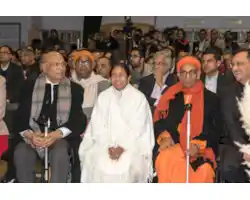14 November 2017
|
English Heritage has unveiled a blue plaque to Sister Nivedita (Margaret Noble, 1867-1911), an educationalist and campaigner for Indian Independence.
English Heritage has unveiled a blue plaque to Sister Nivedita (Margaret Noble, 1867-1911), an educationalist and campaigner for Indian Independence.
Born Margaret Elizabeth Noble in Dungannon, County Tyrone (now in Northern Ireland), Sister Nivedita devoted herself to the support of women’s education and philanthropic work among the poor in India, and also campaigned strongly for Indian independence.
Follow us on facebook
Follow us on twitter
Sign up for our free e-newsletter
Discover Family Tree magazine
Revered within Indian communities in Britain and beyond, Sister Nivedita’s English Heritage blue plaque is at 21A High Street, Wimbledon, a three-storey, late Victorian property of yellow stock brick, now with a shop front, which remained her family’s lodgings whilst she travelled around England, India and France.
Mayor of London, Sadiq Khan, said: “I’m delighted that English Heritage is honouring Sister Nivedita with a blue plaque at her former home in Wimbledon on the 150th anniversary year of her birth.
“Devoting herself to philanthropic work and the promotion of women’s education in India, Sister Nivedita also campaigned tirelessly for Indian independence. This first public recognition of Sister Nivedita in London is a fitting tribute to her lasting legacy, particularly on the 70th anniversary year of India’s independence, and I’m sure it will prove a popular addition to the iconic London Blue Plaques Scheme.”
The story of 'the lioness'
In November 1895, a few years after Margaret Noble opened her own kindergarten, the Ruskin School in Wimbledon, she met Swami Vivekananda (1863-1902), the chief disciple of Ramakrishna Paramahamsa, an Indian mystic and yogi. Drawn by his message of religious universalism and philanthropy, she helped organise the Vedanta Movement in London until she persuaded Vivekananda to let her join him in India in 1898.
This proved to be a turning point in her life and a move that led her to dedicate the rest of her life to India and its people. Vivekananda himself wrote of her devotion: ‘I am now convinced that you have a great future in the work for India. What was wanted was not a man but a woman; a real lioness, to work for the Indians, women especially’. He named her Sister Nivedita or ‘The Dedicated’, when he initiated her as a brahmacharini (a female disciple).
The blue plaque was celebrated in partnership with The Followers of Sister Nivedita and included a dedication by Swami Dayatmananda.
(images copyright English Heritage)









.jpg)